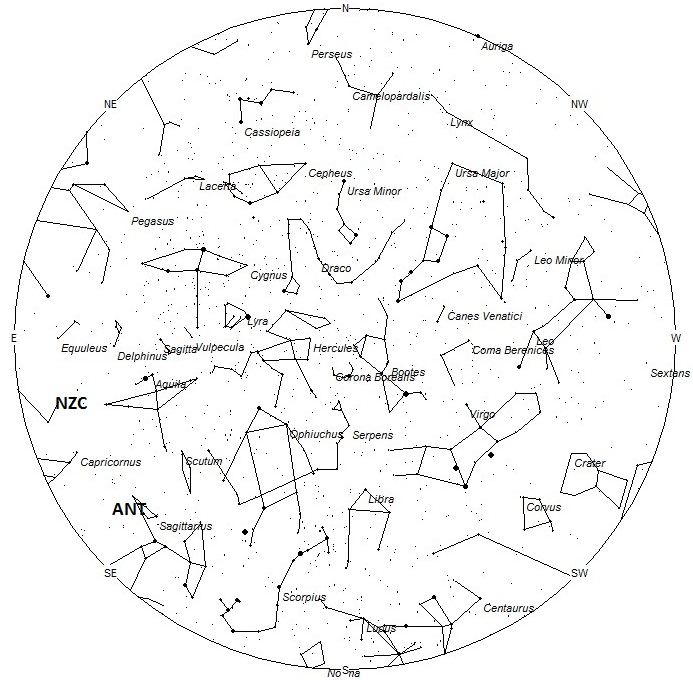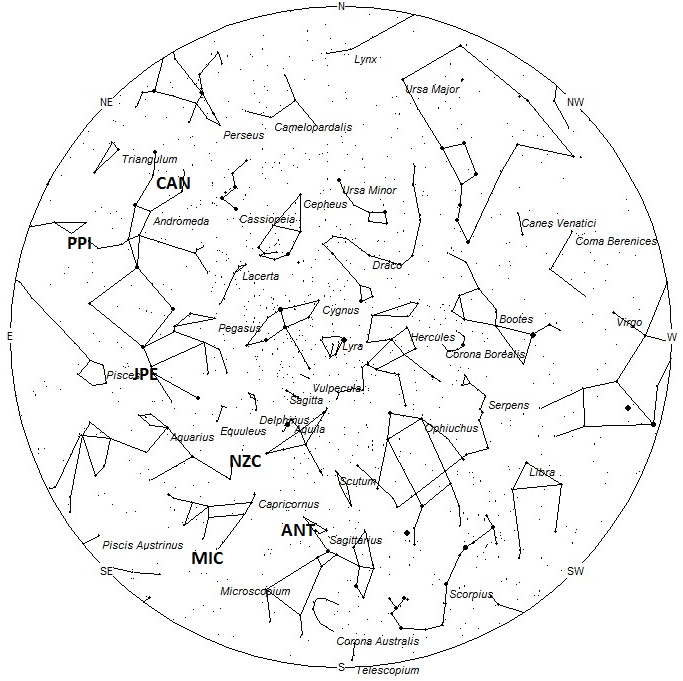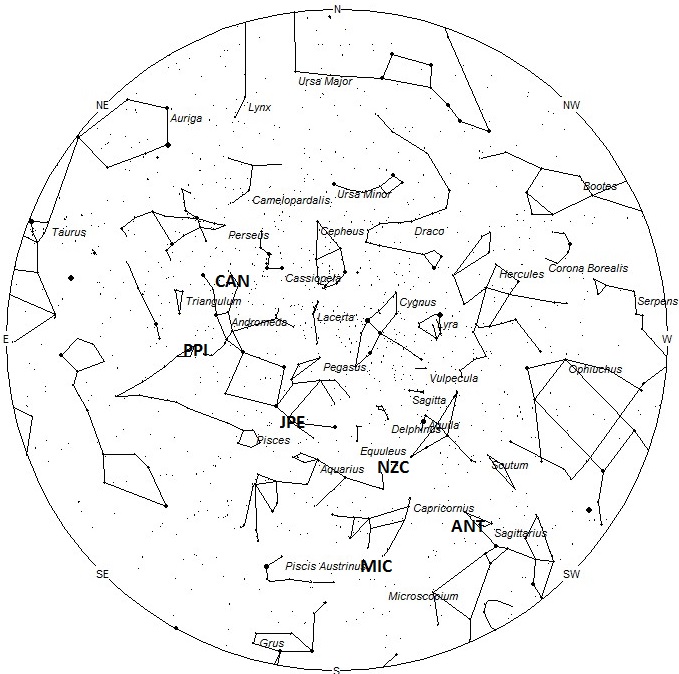
Meteor season finally gets going in July for the northern hemisphere. The first half of the month will be much like June with predominately slow rates. After the 15th though, both sporadic and shower rates increase significantly. For observers in the southern hemisphere, sporadic rates will be falling but the overall activity will increase with the arrival of the Southern delta Aquariids during the last week of the month.
During this period the moon’s phase will increase from half illuminated to nearly full. This weekend the half illuminated moon will set during the early morning hours allowing a couple of hours of viewing under dark conditions. With each passing night this window of opportunity shrinks and by the end of the period the full moon will lie above the horizon nearly the entire night. The estimated total hourly meteor rates for evening observers this week is near 2 for those viewing from the northern hemisphere and 3 for those located south of the equator. For morning observers the estimated total hourly rates should be near 11 as seen from mid-northern latitudes (45N) and 12 as seen from tropical southern locations (25S). The actual rates will also depend on factors such as personal light and motion perception, local weather conditions, alertness and experience in watching meteor activity. Evening rates are reduced due to moonlight during this period. Note that the hourly rates listed below are estimates as viewed from dark sky sites away from urban light sources. Observers viewing from urban areas will see less activity as only the brightest meteors will be visible from such locations.
The radiant (the area of the sky where meteors appear to shoot from) positions and rates listed below are exact for Saturday night/Sunday morning July 1/2. These positions do not change greatly day to day so the listed coordinates may be used during this entire period. Most star atlases (available at science stores and planetariums) will provide maps with grid lines of the celestial coordinates so that you may find out exactly where these positions are located in the sky. A planisphere or computer planetarium program is also useful in showing the sky at any time of night on any date of the year. Activity from each radiant is best seen when it is positioned highest in the sky, either due north or south along the meridian, depending on your latitude. It must be remembered that meteor activity is rarely seen at the radiant position. Rather they shoot outwards from the radiant so it is best to center your field of view so that the radiant lies at the edge and not the center. Viewing there will allow you to easily trace the path of each meteor back to the radiant (if it is a shower member) or in another direction if it is a sporadic. Meteor activity is not seen from radiants that are located far below the horizon. The positions below are listed in a west to east manner in order of right ascension (celestial longitude). The positions listed first are located further west therefore are accessible earlier in the night while those listed further down the list rise later in the night.
These sources of meteoric activity are expected to be active this week.
.
The center of the large Anthelion (ANT) radiant is currently located at 19:32 (293) -22. This position lies in eastern Sagittarius, 4 degrees east of the 3rd magnitude star known as Albaldah (pi Sagittarii). Due to the large size of this radiant, Anthelion activity may also appear from the nearby constellation of Scutum, southern Aquila, and western Carpicornus as well as Sagittarius. This radiant is best placed near 0200 local daylight saving time (LDT), when it lies on the meridian and is located highest in the sky. Hourly rates at this time should be near 1 as seen from mid-northern latitudes and 2 as seen from tropical southern latitudes. With an entry velocity of 30 km/sec., the average Anthelion meteor would be of slow velocity.
The Northern June Aquilids (NCZ) were discovered by Zdenek Sekanina. These meteors are active from June 5-July 22, with maximum activity occurring on the July 3. The current position of the radiant is 20:38 (309) -06. This position lies in on the Aquila/Aquarius border, 2 degrees west of the faint star known as 3 Aquarii. Current rates are expected to be near 2 per hour, no matter your location. With an entry velocity of 38 km/sec., the average Northern June Aquilid meteor would be of medium speed.
The Microscopiids (MIC) were discovered by Dr. Peter Brown in his meteoroid stream survey using the Canadian Meteor Orbit Radar. This stream has been verified by Sirko Molau using data from video cameras located in Australia, where the radiant lies high in the sky. These meteors are active from June 30-July 13, with maximum activity occurring on July 6. The current position of the radiant is 21:00 (315) -29. This position lies in northern Microscopium, 3 degrees southeast of the 4th magnitude star known as omega Capricornii. Current rates are expected to be less than 1 per hour, no matter your location. With an entry velocity of 39 km/sec., the average meteor from this source would be of medium speed. This stream is confusingly listed as the Southern June Aquilids in the IAU catalog. It actually lies quite far from the constellation of Aquila.
The July Pegasids (JPE) have been noticed for some time now but have had a checkered history. It has been added, dropped, and then re-added to several radiant lists. Video studies within the past 10 years has positively identified this source as an active radiant during the entire month of July. Maximum activity occurs on July 10th. The radiant is currently located at 22:44 (341) +09. This area of the sky is located in southern Pegasus, just southeast of the 3rd magnitude star known as Homam (Zeta Pegasi). This area of the sky is best seen during the last dark hour before dawn when the radiant lies highest in a dark sky. Rates are expected to be less than 1 per hour this week no matter your location. Rates should increase to near 2 per hour at maximum. With an entry velocity of 68 km/sec., the average meteor from this source would be of swift velocity.
The phi Piscids (PPS) were also discovered by Dr. Peter Brown and associates. This shower was later verified by Dr. Peter Jenniskens and David Holman using data from the CAMS network in northern California. These meteors are active from June 8 through August 2 with maximum activity occurring on July 5. The current position of the radiant is 00:56 (014) +24. This position lies on the Pisces/Andromeda border, just south of the 4th magnitude star known as eta Andromedae. Rates are currently expected to be near 1 per hour as seen from the northern hemisphere and less than 1 as seen from south of the equator. With an entry velocity of 66 km/sec., the average Pi Piscid meteor would be of swift speed.
The c-Andromedids (CAN) were discovered by Sirko Molau and Juergen Rendtel using video data from the IMO network. Activity from this source is seen from June 26 though July 27 with maximum activity occurring on July 9. The radiant currently lies at 01:24 (021) +45, which places it in northeastern Andromeda, 3 degrees southeast of the 4th magnitude star known as phi Andromedae. This area of the sky is best seen during the last dark hour before dawn when the radiant lies highest in a dark sky. Observers in the northern hemisphere are better situated to view this activity as the radiant rises much higher in the sky before dawn compared to southern latitudes. Current rates would be less than 1 per hour no matter your location. With an entry velocity of 58 km/sec., the average meteor from this source would be of swift velocity.
As seen from the mid-northern hemisphere (45N) one would expect to see approximately 7 sporadic meteors per hour during the last hour before dawn as seen from rural observing sites. Evening rates would be near 1 per hour. As seen from the tropical southern latitudes (25S), morning rates would be near 8 per hour as seen from rural observing sites and 2 per hour during the evening hours. Locations between these two extremes would see activity between the listed figures. Evening rates are reduced due to moonlight.
The list below offers the information from above in tabular form. Rates and positions are exact for Saturday night/Sunday morning except where noted in the shower descriptions.
| SHOWER | DATE OF MAXIMUM ACTIVITY | CELESTIAL POSITION | ENTRY VELOCITY | CULMINATION | HOURLY RATE | CLASS |
| RA (RA in Deg.) DEC | Km/Sec | Local Daylight Saving Time | North-South | |||
| Anthelions (ANT) | – | 19:32 (293) -22 | 30 | 02:00 | 1 – 2 | III |
| Northern June Aquilids (NCZ) | Jul 03 | 20:38 (309) -06 | 38 | 03:00 | 2 – 2 | II |
| Microscopiids (MIC) | Jul 06 | 21:00 (315) -29 | 39 | 03:00 | <1 – <1 | IV |
| July Pegasids (JPE) | Jul 10 | 22:44 (341) +09 | 68 | 04:00 | <1 – <1 | IV |
| phi Piscids (PPS) | Jul 02 | 00:56 (014) +24 | 66 | 06:00 | 1 – <1 | IV |
| c-Andromedids (CAN) | Jul 09 | 01:24 (021) +45 | 58 | 07:00 | <1 – <1 | IV |
 American Meteor Society
American Meteor Society



Just before bed, 11;30 cst in central Minnesota I shut off the lights and sat down to look out my north facing picture window and seen 5-7 brief glimpses and one slow moving with longer trail.All where high in the sky radiating from Cassiopeia within 15 minutes as well . Very surprising because the moon was out, the sky was clear and I was looking through a window I have seen many very nice meteors, however since having lasik done I see only the better and slower streaks ..Was I witnessing Northern June Aquilids?
Mike and All,
If these meteors radiated from Cassiopeia, then they were not Northern June Aquiliids. Northern June Aquiliids radiate from an area near the Capricornus/Aquila border.
There is no known radiant currently active in Cassiopeia. Perhaps you witnessed an outburst from an unknown source?
Robert Lunsford